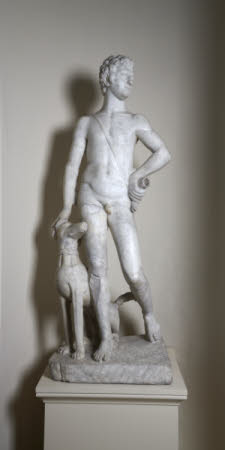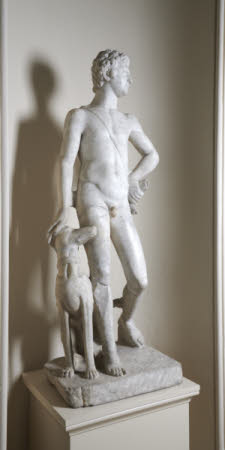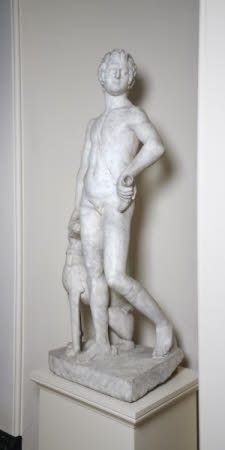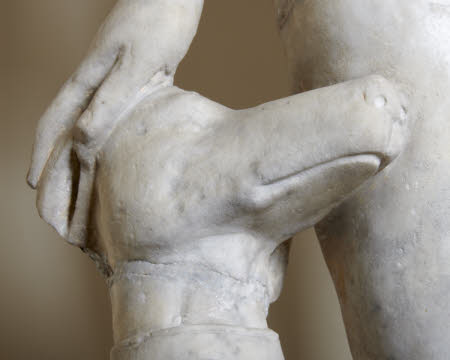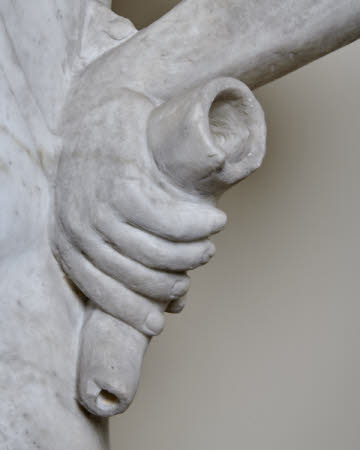The huntsman Adonis with his hound.
Italian (Florentine) School
Category
Art / Sculpture
Date
c. 1560 - 1600
Materials
Marble
Measurements
1780 x 680 x 490 mm
Place of origin
Florence
Order this imageCollection
Mount Stewart, County Down
NT 1542340
Summary
Sculpture, marble; Adonis with his hound; Italian, probably Florentine; c. 1560-1600. A full-size marble statue of the huntsman Adonis, depicted with his hound
Full description
A marble statue of the huntsman Adonis, depicted entirely naked, except for the strap over his shoulder that holds his hunting horn. He moves forwards on his right leg, his head turned to his left, his left hand grasping his horn, as if he has just become aware of the presence of quarry, and is about to blow on the horn. With his right hand he caresses the head of his hound, which is seated and also looks to its left. On an integral rectangular base. The sculpture is severely weathered and has suffered further damage. The right leg has been shattered and repaired, with lead infills at the back. There are further repairs at the right knee and in the right thigh. The hound’s head has been broken at the neck and repaired. Although it could represent another huntsman figure such as Meleager, the statue is most likely to depict the popular subject of Adonis. Born from the incestuous union of King Cinyras of Paphos with his daughter Myrrha, Adonis became famed for his extraordinary beauty. Accidentally receiving a scratch from one of her son Cupid's arrows, the goddess of love Venus herself fell passionately in love with Adonis. As a result, she became oblivious to everything ouside her passion for the young man (Ovid, Metamorphoses, X, 516-59). Accompanying him on his hunting expeditions, Venus would beg Adonis to beware the strength and violence of wild beasts and indeed, on the day of his death, a premonition warned her that he would die if he went hunting tat day. Adonis was however impatient of her warnings and struggled to be free, as depicted in Giovanni Francesco Susini’s bronze group at Anglesey Abbey (NT 515032). As Venus had been warned, her lover was gored to death by a fierce wild boar. He died in the arms of the grief-stricken goddess, who turned his blood into the anemone flower (Metamorphoses, X, 702-39). The sculpture would appear to be a typical, if not especially distinguished, late mannerist Florentine work, from the second half of the sixteenth century. It may be compared with the figure of Jason in the Victoria & Albert Museum (Inv. 6735-1860; Pope-Hennessy 1964, II, pp. 485-87, no. 514, fig. 511), formerly in the gardens of the Palazzo Strozzi-Ridolfi in Florence. The figure is loosely based on one of the most celebrated of all classical sculptures, the Apollo Belvedere in the Vatican Museums (Haskell and Penny 1981, no. 8). The sculpture takes from the Apollo Belvedere the pose of the figure moving forward with the head turned sharply to the left. The tree trunk in the Vatican sculpture is here replaced by Adonis's hound. Jeremy Warren September 2022
Provenance
Wynyard Park; on loan from the Estate of the Marquess of Londonderry
Credit line
On loan from the Trustees of the 9th Marquess of Londonderry Heirlooms Settlement
Makers and roles
Italian (Florentine) School, sculptor
References
Wynyard 1949: Inventory and Valuation of the Contents of Wynyard Park, Co. Durham, the property of the Most Honourable the Marquess of Londonderry… deceased. Prepared for the purpose of probate by H. Clifford-Smith. 1949, p. 35, Statue Hall. Pope-Hennessy 1964: John Pope-Hennessy, Catalogue of Italian Sculpture in the Victoria & Albert Museum, 3 vols., London 1964 Haskell and Penny 1981: Francis Haskell and Nicholas Penny, Taste and the Antique, The Lure of Classical Sculpture 1500 - 1900, New Haven and London, 1981
